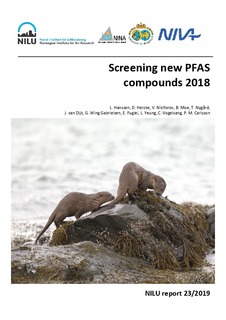| dc.contributor.author | Hanssen, Linda | |
| dc.contributor.author | Herzke, Dorte | |
| dc.contributor.author | Nikiforov, Vladimir | |
| dc.contributor.author | Moe, Børge | |
| dc.contributor.author | Nygård, Torgeir | |
| dc.contributor.author | van Dijk, Jiska Joanneke | |
| dc.contributor.author | Gabrielsen, Geir Wing | |
| dc.contributor.author | Fuglei, Eva | |
| dc.contributor.author | Yeung, Leo | |
| dc.contributor.author | Vogelsang, Christian | |
| dc.contributor.author | Carlsson, Pernilla Marianne | |
| dc.date.accessioned | 2019-12-13T09:25:00Z | |
| dc.date.available | 2019-12-13T09:25:00Z | |
| dc.date.created | 2019-12-12T10:20:54Z | |
| dc.date.issued | 2019 | |
| dc.identifier.isbn | 978-82-425-2992-3 | |
| dc.identifier.issn | 2464-3327 | |
| dc.identifier.uri | http://hdl.handle.net/11250/2633096 | |
| dc.description.abstract | This screening project has focused on the occurrence of conventional and emerging PFASs in terrestrial and marine environments, including the Arctic. Conventional PFASs were found to be wide-spread in the environment and for the first time in Norway reported in wolf, a top predator from the terrestrial environment. Otters living in close proximity to human settlements and preying on the marine food chain, are heavily contaminated with PFASs. Areas where ski-testing activities are common are a potential “hotspot” where PFASs can enter the food chain. The difference in PFAS-profile between the samples indicates that the diversity in samples are necessary to reveal the complete picture of PFASs in the environment. | nb_NO |
| dc.description.abstract | I dette screeningprosjektet ble det fokusert på forekomsten av vanlige og nye PFAS-eri terrestrisk og marint miljø, inkludert arktisk.De vanlige PFAS-ene blefunneti alle typer prøver, og ble for første gang rapportert i norsk ulv, en toppredator i det terrestriske miljøet. Oter som lever tett på menneskelige aktiviteter og er en del av den marine næringskjeden,har de høyeste mengdene av vanlige PFAS-er i denne screeningen. Resultatene viser også at områder hvor det foregår skitestinger potensielle punktkilder. Forskjellen i PFAS-profil mellom prøvene viser at forskjellige typer prøver er viktig for å få et fullstendig bilde av PFAS-er i miljøet. | nb_no |
| dc.language.iso | eng | nb_NO |
| dc.publisher | NILU | nb_NO |
| dc.relation.ispartof | NILU rapport | |
| dc.relation.ispartofseries | NILU report;23/2019 | |
| dc.relation.ispartofseries | Norwegian Environment Agency;M-1491|2019 | |
| dc.subject | Miljøkjemi | nb_NO |
| dc.subject | Environmental chemistry | nb_NO |
| dc.subject | Polare områder | nb_NO |
| dc.subject | Polar regions | nb_NO |
| dc.subject | PFAS | nb_NO |
| dc.title | Screening new PFAS compounds 2018 | nb_NO |
| dc.title.alternative | Screening av nye PFAS-stoffer 2018 | nb_NO |
| dc.type | Research report | nb_NO |
| dc.description.version | publishedVersion | nb_NO |
| dc.rights.holder | © NILU –Norwegian Institute for Air Research | nb_NO |
| dc.source.pagenumber | 96 | nb_NO |
| dc.source.issue | 23/2019 | nb_NO |
| dc.identifier.cristin | 1759807 | |
| dc.relation.project | NILU - Norsk institutt for luftforskning: 118084 | nb_NO |
| dc.relation.project | Miljødirektoratet: * | nb_NO |
| cristin.unitcode | 7460,60,0,0 | |
| cristin.unitname | Miljøkjemi | |
| cristin.ispublished | true | |
| cristin.fulltext | original | |
